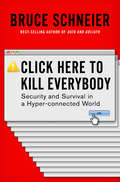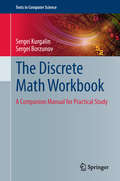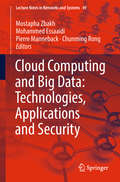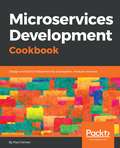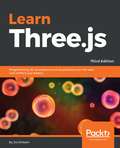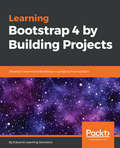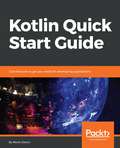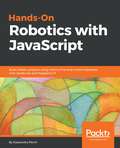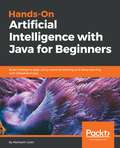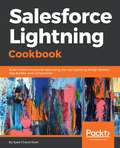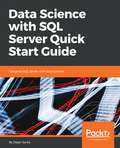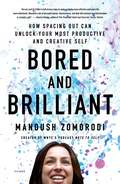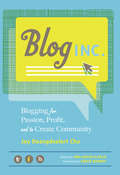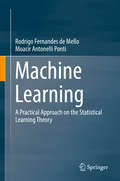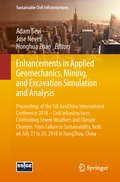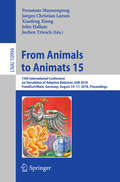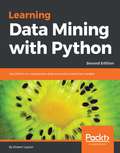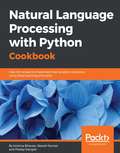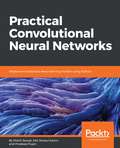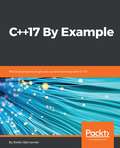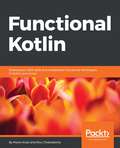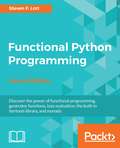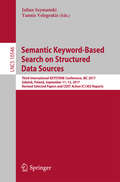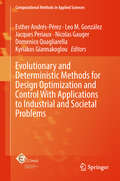- Table View
- List View
Click Here to Kill Everybody: Security And Survival In A Hyper-connected World
by Bruce SchneierA world of "smart" devices means the Internet can kill people. We need to act. Now. Everything is a computer. Ovens are computers that make things hot; refrigerators are computers that keep things cold. These computers—from home thermostats to chemical plants—are all online. The Internet, once a virtual abstraction, can now sense and touch the physical world. As we open our lives to this future, often called the Internet of Things, we are beginning to see its enormous potential in ideas like driverless cars, smart cities, and personal agents equipped with their own behavioral algorithms. But every knife cuts two ways. All computers can be hacked. And Internet-connected computers are the most vulnerable. Forget data theft: cutting-edge digital attackers can now crash your car, your pacemaker, and the nation’s power grid. In Click Here to Kill Everybody, renowned expert and best-selling author Bruce Schneier examines the hidden risks of this new reality. After exploring the full implications of a world populated by hyperconnected devices, Schneier reveals the hidden web of technical, political, and market forces that underpin the pervasive insecurities of today. He then offers common-sense choices for companies, governments, and individuals that can allow us to enjoy the benefits of this omnipotent age without falling prey to its vulnerabilities. From principles for a more resilient Internet of Things, to a recipe for sane government regulation and oversight, to a better way to understand a truly new environment, Schneier’s vision is required reading for anyone invested in human flourishing.
The Discrete Math Workbook: A Companion Manual for Practical Study (Texts in Computer Science)
by Sergei Kurgalin Sergei BorzunovThis practically-oriented textbook presents an accessible introduction to discrete mathematics through a substantial collection of classroom-tested exercises. Each chapter opens with concise coverage of the theory underlying the topic, reviewing the basic concepts and establishing the terminology, as well as providing the key formulae and instructions on their use. This is then followed by a detailed account of the most common problems in the area, before the reader is invited to practice solving such problems for themselves through a varied series of questions and assignments.Topics and features: provides an extensive set of exercises and examples of varying levels of complexity, suitable for both laboratory practical training and self-study; offers detailed solutions to many problems, applying commonly-used methods and computational schemes; introduces the fundamentals of mathematical logic, the theory of algorithms, Boolean algebra, graph theory, sets, relations, functions, and combinatorics; presents more advanced material on the design and analysis of algorithms, including asymptotic analysis, and parallel algorithms; includes reference lists of trigonometric and finite summation formulae in an appendix, together with basic rules for differential and integral calculus.This hands-on study guide is designed to address the core needs of undergraduate students training in computer science, informatics, and electronic engineering, emphasizing the skills required to develop and implement an algorithm in a specific programming language.
Cloud Computing and Big Data: Technologies, Applications and Security (Lecture Notes in Networks and Systems #49)
by Mostapha Zbakh Mohammed Essaaidi Pierre Manneback Chunming RongThis book addresses topics related to cloud and Big Data technologies, architecture and applications including distributed computing and data centers, cloud infrastructure and security, and end-user services. The majority of the book is devoted to the security aspects of cloud computing and Big Data. Cloud computing, which can be seen as any subscription-based or pay-per-use service that extends the Internet’s existing capabilities, has gained considerable attention from both academia and the IT industry as a new infrastructure requiring smaller investments in hardware platforms, staff training, or licensing software tools. It is a new paradigm that has ushered in a revolution in both data storage and computation. In parallel to this progress, Big Data technologies, which rely heavily on cloud computing platforms for both data storage and processing, have been developed and deployed at breathtaking speed. They are among the most frequently used technologies for developing applications and services in many fields, such as the web, health, and energy. Accordingly, cloud computing and Big Data technologies are two of the most central current and future research mainstreams. They involve and impact a host of fields, including business, scientific research, and public and private administration. Gathering extended versions of the best papers presented at the Third International Conference on Cloud Computing Technologies and Applications (CloudTech’17), this book offers a valuable resource for all Information System managers, researchers, students, developers, and policymakers involved in the technological and application aspects of cloud computing and Big Data.
Algorithmic Aspects of Machine Learning
by Ankur MoitraThis book bridges theoretical computer science and machine learning by exploring what the two sides can teach each other. It emphasizes the need for flexible, tractable models that better capture not what makes machine learning hard, but what makes it easy. Theoretical computer scientists will be introduced to important models in machine learning and to the main questions within the field. Machine learning researchers will be introduced to cutting-edge research in an accessible format, and gain familiarity with a modern, algorithmic toolkit, including the method of moments, tensor decompositions and convex programming relaxations. The treatment beyond worst-case analysis is to build a rigorous understanding about the approaches used in practice and to facilitate the discovery of exciting, new ways to solve important long-standing problems.
Microservices Development Cookbook: Design and build independently deployable, modular services
by Paul OsmanQuickly learn and employ practical methods for developing microservicesKey FeaturesGet to grips with microservice architecture to build enterprise-ready applicationsAdopt the best practices to find solutions to specific problemsMonitor and manage your services in productionBook DescriptionMicroservices have become a popular way to build distributed systems that power modern web and mobile apps. Deploying your application as a suite of independently deployable, modular, and scalable services has many benefits. In this book, you'll learn to employ microservices in order to make your application more fault-tolerant and easier to scale and change.Using an example-driven approach, Microservice Development Cookbook introduces you to the microservice architectural style. You'll learn how to transition from a traditional monolithic application to a suite of small services that interact to provide smooth functionality to your client applications. You'll also learn about the patterns used to organize services, so you can optimize request handling and processing and see how to handle service-to-service interactions. You'll then move on to understanding how to secure microservices and add monitoring in order to debug problems. This book also covers fault-tolerance and reliability patterns that help you use microservices to isolate failures in your applications.By the end of the book, you’ll be able to work with a team to break a large, monolithic codebase into independently deployable and scalable microservices. You'll also study how to efficiently and effortlessly manage a microservice-based architecture.What you will learnLearn how to design microservice-based systemsCreate services that fail without impacting usersMonitor your services to perform debugging and create observable systemsManage the security of your servicesCreate fast and reliable deployment pipelinesManage multiple environments for your servicesSimplify the local development of microservice-based systemsWho this book is forMicroservice Development Cookbook is for developers who would like to build effective and scalable microservices. Basic knowledge of the microservices architecture is assumed.
Learn Three.js: Programming 3D animations and visualizations for the web with HTML5 and WebGL, 3rd Edition
by Jos DirksenCreate and animate stunning 3D browser based graphics with Three.js JavaScript libraryKey FeaturesEnhance your 3D graphics with light sources, shadows, advanced materials, and texturesLoad models from external sources, and visualize and animate them directly from JavaScriptCreate your own custom WebGL shader and explore the postprocessing feature of Three.jsBook DescriptionWebGL makes it possible to create 3D graphics in the browser without having to use plugins such as Flash and Java. Programming WebGL, however, is difficult and complex. With Three.js, it is possible to create stunning 3D graphics in an intuitive manner using JavaScript, without having to learn WebGL. With this book, you’ll learn how to create and animate beautiful looking 3D scenes directly in your browser-utilizing the full potential of WebGL and modern browsers. It starts with the basic concepts and building blocks used in Three.js. From there on, it will expand on these subjects using extensive examples and code samples. You will learn to create, or load, from externally created models, realistic looking 3D objects using materials and textures. You’ll find out how to easily control the camera using the Three.js built-in in camera controls, which will enable you to fly or walk around the 3D scene you created. You will then use the HTML5 video and canvas elements as a material for your 3D objects and to animate your models. Finally, you will learn to use morph and skeleton-based animation, and even how to add physics, such as gravity and collision detection, to your scene. After reading this book, you’ll know everything that is required to create 3D animated graphics using Three.js.What you will learnWork with the different types of materials in Three.js and see how they interact with your 3D objects and the rest of the environmentImplement the different camera controls provided by Three.js to effortlessly navigate around your 3D sceneWork with vertices directly to create snow, rain, and galaxy-like effectsImport and animate models from external formats, such as OBJ, STL, and COLLADACreate and run animations using morph targets and bones animationsExplore advanced textures on materials to create realistic looking 3D objects by using bump maps, normal maps, specular maps, and light mapsInteract directly with WebGL by creating custom vertex and fragment shadersWho this book is forThe ideal target audience for this book would be JavaScript developers who who want to learn how to use the Three.js library
Learning Bootstrap 4 by Building Projects: Develop 5 real-world Bootstrap 4.x projects from scratch
by Eduonix Learning SolutionsPractical guide to learning responsive web development with the powerful JavaScript Library, BootstrapKey FeaturesCreate 5 responsive web apps with Bootstrap 4Use elements and full Bootstrap toolkit to construct custom animations and templatesDesign, customize, and create existing UIs and media aggregator appsBook DescriptionBootstrap, the world’s most popular frontend framework, is an open source toolkit for building web applications with HTML, CSS, and JavaScript.Learning Bootstrap 4 by Building Projects covers the essentials of Bootstrap 4 along with best practices. The book begins by introducing you to the latest features of Bootstrap 4. You will learn different elements and components of Bootstrap, such as the strict grid system, Sass, which replaced Less, flexbox, Font Awesome, and cards. As you make your way through the chapters, you will use a template that will help you to build different kinds of real-world websites, such as a social media website, a company landing page, a media hosting website, and a profile page, with ease.By the end of this book, you will have built websites that are visually appealing, responsive, and robust.What you will learnGet familiar with the new features of Bootstrap 4Understand how the new grid system worksLearn to use the Sass tool in BootstrapAutomate your tasks using the task runner, GulpUse Lightbox to build a photo galleryMaster best practices for HTML, CSS, and JavaScriptWho this book is forLearning Bootstrap 4 by Building Projects is for web developers who want to build real-world responsive websites from scratch using Bootstrap 4. Basic knowledge of HTML and CSS is required.
Kotlin Quick Start Guide: Core features to get you ready for developing applications
by Marko DevcicGet started with Kotlin programming for building real world applicationsKey FeaturesStart programming with KotlinExplore Kotlin language syntax, standard libraries and Java InteroperabilityBuilds an example application with what you learnBook DescriptionKotlin is a general purpose, object-oriented language that primarily targets the JVM and Android. Intended as a better alternative to Java, its main goals are high interoperability with Java and increased developer productivity. Kotlin is still a new language and this book will help you to learn the core Kotlin features and get you ready for developing applications with Kotlin.This book covers Kotlin features in detail and explains them with practical code examples.You will learn how to set up the environment and take your frst steps with Kotlin and its syntax. We will cover the basics of the language, including functions, variables, and basic data types. With the basics covered, the next chapters show how functions are first-class citizens in Kotlin and deal with the object-oriented side of Kotlin.You will move on to more advanced features of Kotlin. You will explore Kotlin's Standard Library and learn how to work with the Collections API. The book finishes by putting Kotlin in to practice, showing how to build a desktop app.By the end of this book, you will be confident enough to use Kotlin for your next project.What you will learnProgramming in Kotlin language syntax, basic types, control ?ow, classes, and OOPWriting functions and functional programming in KotlinDefning and importing from packages in KotlinRunning Kotlin on JVMs and Android runtimesWorking with the Kotlin Standard Library and advanced features of Kotlin programmingSetting up a Kotlin development environment with JetBrains toolsBuilding real-world applications with KotlinWho this book is forThis book is intended for anybody who wants to learn the most important Kotlin features. No experience of Kotlin is expected.
Hands-On Robotics with JavaScript: Build robotic projects using Johnny-Five and control hardware with JavaScript and Raspberry Pi
by Kassandra PerchLeverage Raspberry Pi 3 and different JavaScript platforms to build exciting Robotics projectsKey FeaturesBuild robots that light up and make noiseLearn to work with Raspberry Pi 3 and JavaScriptConnect your Johnny-Five projects to external APIs and create your own IoTBook DescriptionThere has been a rapid increase in the use of JavaScript in hardware and embedded device programming. JavaScript has an effective set of frameworks and libraries that support the robotics ecosystem.Hands-On Robotics with JavaScript starts with setting up an environment to program robots in JavaScript. Then, you will dive into building basic-level projects such as a line-following robot. You will walk through a series of projects that will teach you about the Johnny-Five library, and develop your skills with each project. As you make your way through the chapters, you’ll work on creating a blinking LED, before moving on to sensors and other more advanced concepts. You will then progress to building an advanced-level AI-enabled robot, connect their NodeBots to the internet, create a NodeBots Swarm, and explore MQTT.By the end of this book, you will have gained hands-on experience in building robots using JavaScriptWhat you will learnInstall and run Node.js and Johnny-Five on Raspberry PiAssemble, code, and run an LED projectLeverage JavaScript libraries to build exciting robotsUse sensors to collect data from the world around youEmploy servos and motors to make your project moveAdd internet capabilities to your Johnny-Five projectWho this book is forHands-On Robotics with JavaScript is for individuals who have prior experience with Raspberry Pi 3 and like to write sketches in JavaScript. Basic knowledge of JavaScript and Node.js will help you get the most out of this book.
Hands-On Artificial Intelligence with Java for Beginners: Build intelligent apps using machine learning and deep learning with Deeplearning4j
by Nisheeth JoshiBuild, train, and deploy intelligent applications using Java librariesKey FeaturesLeverage the power of Java libraries to build smart applicationsBuild and train deep learning models for implementing artificial intelligenceLearn various algorithms to automate complex tasksBook DescriptionArtificial intelligence (AI) is increasingly in demand as well as relevant in the modern world, where everything is driven by technology and data. AI can be used for automating systems or processes to carry out complex tasks and functions in order to achieve optimal performance and productivity.Hands-On Artificial Intelligence with Java for Beginners begins by introducing you to AI concepts and algorithms. You will learn about various Java-based libraries and frameworks that can be used in implementing AI to build smart applications. In addition to this, the book teaches you how to implement easy to complex AI tasks, such as genetic programming, heuristic searches, reinforcement learning, neural networks, and segmentation, all with a practical approach.By the end of this book, you will not only have a solid grasp of AI concepts, but you'll also be able to build your own smart applications for multiple domains.What you will learnLeverage different Java packages and tools such as Weka, RapidMiner, and Deeplearning4j, among othersBuild machine learning models using supervised and unsupervised machine learning techniquesImplement different deep learning algorithms in Deeplearning4j and build applications based on themStudy the basics of heuristic searching and genetic programmingDifferentiate between syntactic and semantic similarity among textsPerform sentiment analysis for effective decision making with LingPipeWho this book is forHands-On Artificial Intelligence with Java for Beginners is for Java developers who want to learn the fundamentals of artificial intelligence and extend their programming knowledge to build smarter applications.
Salesforce Lightning Cookbook: Build modern enterprise apps using the new Lightning Design System, App Builder, and Components
by Syed Chand ShahOver 25 recipes to help you design and test informative applications on the Salesforce Lightning platformKey FeaturesLearn Salesforce Lightning concepts from scratch.Build scalable enterprise apps with Salesforce design guidelines and the CSS frameworkUse Visualforce to build custom user interfaces for mobile and web appsBook DescriptionThe new Lightning Experience combines three major components—Lightning Design System, Lightning App Builder, and Lightning Components—to enable anyone to quickly and easily create beautiful, modern enterprise apps. If you wish to meet the challenges that Lightning throws at you head-on, then look no further because this practical book will be your faithful companion and ensure that you make best use of the Lightning platform.The book starts by walking you through the three major Lightning Components and helps you enable and configure a Lightning solution. You will explore the art of working with standard components and build a basic layout for the application. Then, you will add more advanced components using the Lightning Framework. Finally, you will also build and migrate reports and dashboards to make your app look more professional. Towards the end of the book, you’ll make use of Design System to work with Salesforce data and lay out the entire page with the components that you’ve built, before integrating Visualforce in your application.What you will learnEnable and configure a Lightning solutionCreate standard Lightning solutions and build a basic page layoutAdd custom components to your Lightning pagesBuild and migrate reports and dashboardsIntegrate Lightning pages with Visualforce to enhance performanceAdd stunning custom designs and styling with Lightning Design SystemWho this book is forThis book is ideal for Salesforce developers, admins, sales consultants, and sales managers who are comfortable with using Lightning features to build basic apps. Experience with JavaScript, CSS, and HTML would be an advantage but not compulsory.
Data Science with SQL Server Quick Start Guide: Integrate SQL Server with data science
by Dejan SarkaGet unique insights from your data by combining the power of SQL Server, R and PythonKey FeaturesUse the features of SQL Server 2017 to implement the data science project life cycleLeverage the power of R and Python to design and develop efficient data modelsfind unique insights from your data with powerful techniques for data preprocessing and analysisBook DescriptionSQL Server only started to fully support data science with its two most recent editions. If you are a professional from both worlds, SQL Server and data science, and interested in using SQL Server and Machine Learning (ML) Services for your projects, then this is the ideal book for you.This book is the ideal introduction to data science with Microsoft SQL Server and In-Database ML Services. It covers all stages of a data science project, from businessand data understanding,through data overview, data preparation, modeling and using algorithms, model evaluation, and deployment.You will learn to use the engines and languages that come with SQL Server, including ML Services with R and Python languages and Transact-SQL. You will also learn how to choose which algorithm to use for which task, and learn the working of each algorithm.What you will learnUse the popular programming languages,T-SQL, R, and Python, for data scienceUnderstand your data with queries and introductory statisticsCreate and enhance the datasets for MLVisualize and analyze data using basic and advanced graphsExplore ML using unsupervised and supervised modelsDeploy models in SQL Server and perform predictionsWho this book is forSQL Server professionals who want to start with data science, and data scientists who would like to start using SQL Server in their projects will find this book to be useful. Prior exposure to SQL Server will be helpful.
Bored and Brilliant: How Spacing Out Can Unlock Your Most Productive and Creative Self
by Manoush Zomorodi"Bored and Brilliant shows the fascinating side of boredom. Manoush Zomorodi investigates cutting-edge research as well as compelling (and often funny) real-life examples to demonstrate that boredom is actually a crucial tool for making our lives happier, more productive, and more creative. What’s more, the book is crammed with practical exercises for anyone who wants to reclaim the power of spacing out – deleting the Two Dots app, for instance, or having a photo-free day, or taking a 'fakecation'." —Gretchen Rubin, author of #1 NYT Bestseller The Happiness Project"Bored and Brilliant is full of easy steps to make each day more effective and every life more intentional. Manoush’s mix of personal stories, neuroscience, and data will convince you that boredom is actually a gift." —Charles Duhigg, author of The Power of Habit and Smarter, Faster, BetterIt’s time to move “doing nothing” to the top of your to-do list.In 2015 Manoush Zomorodi, host of WNYC’s popular podcast and radio show Note to Self, led tens of thousands of listeners through an experiment to help them unplug from their devices, get bored, jump-start their creativity, and change their lives. Bored and Brilliant builds on that experiment to show us how to rethink our gadget use to live better and smarter in this new digital ecosystem. Manoush explains the connection between boredom and original thinking, exploring how we can harness boredom’s hidden benefits to become our most productive and creative selves without totally abandoning our gadgets in the process. Grounding the book in the neuroscience and cognitive psychology of “mind wandering” what our brains do when we're doing nothing at all—Manoush includes practical steps you can take to ease the nonstop busyness and enhance your ability to dream, wonder, and gain clarity in your work and life. The outcome is mind-blowing. Unplug and read on.
Blog, Inc.: Blogging for Passion, Profit, and to Create Community (Inc Ser.)
by Joy Deangdeelert Cho Meg Mateo Ilasco Grace BonneyWith roughly 95,000 blogs launched worldwide every 24 hours (BlogPulse), making a fledgling site stand out isn't easy. This authoritative handbook gives creative hopefuls a leg up. Joy Cho, of the award-winning Oh Joy!, offers expert advice on starting and growing a blog, from design and finance to overcoming blogger's block, attracting readers, and more. With a foreword from Grace Bonney of Design*Sponge plus expert interviews, this book will fine-tune what the next generation of bloggers shares with the world.
Machine Learning: A Practical Approach on the Statistical Learning Theory
by Rodrigo Fernandes de Mello Moacir Antonelli PontiThis book presents the Statistical Learning Theory in a detailed and easy to understand way, by using practical examples, algorithms and source codes. It can be used as a textbook in graduation or undergraduation courses, for self-learners, or as reference with respect to the main theoretical concepts of Machine Learning. Fundamental concepts of Linear Algebra and Optimization applied to Machine Learning are provided, as well as source codes in R, making the book as self-contained as possible.It starts with an introduction to Machine Learning concepts and algorithms such as the Perceptron, Multilayer Perceptron and the Distance-Weighted Nearest Neighbors with examples, in order to provide the necessary foundation so the reader is able to understand the Bias-Variance Dilemma, which is the central point of the Statistical Learning Theory.Afterwards, we introduce all assumptions and formalize the Statistical Learning Theory, allowing the practical study of different classification algorithms. Then, we proceed with concentration inequalities until arriving to the Generalization and the Large-Margin bounds, providing the main motivations for the Support Vector Machines. From that, we introduce all necessary optimization concepts related to the implementation of Support Vector Machines. To provide a next stage of development, the book finishes with a discussion on SVM kernels as a way and motivation to study data spaces and improve classification results.
Enhancements in Applied Geomechanics, Mining, and Excavation Simulation and Analysis: Proceedings of the 5th GeoChina International Conference 2018 – Civil Infrastructures Confronting Severe Weathers and Climate Changes: From Failure to Sustainability, held on July 23 to 25, 2018 in HangZhou, China (Sustainable Civil Infrastructures)
by Adam Sevi Jose Neves Honghua ZhaoThe book presents a compilation of studies regarding applied geomechanics, mining, and excavation analysis and simulation. The material is suitable for presentation to senior undergraduate and post-graduate students in both mining and geological engineering. It should also be of interest to students of other aspects of Geomechanics and, notably, engineering geologists interested in mining and underground excavation design. Practising mining engineers and rock mechanics engineers involved in mine design may use the book profitably to obtain an appreciation of the current state of engineering knowledge in their area of specialisation. Papers were selected from the 5th GeoChina International Conference on Civil Infrastructures Confronting Severe Weathers and Climate Changes: From Failure to Sustainability, held in July 23-25, 2018 in Hang Zhou, China.
From Animals to Animats 15: 15th International Conference on Simulation of Adaptive Behavior, SAB 2018, Frankfurt/Main, Germany, August 14-17, 2018, Proceedings (Lecture Notes in Computer Science #10994)
by Poramate Manoonpong Jørgen Christian Larsen Xiaofeng Xiong John Hallam Jochen TrieschThis book constitutes the refereed proceedings of the 15th International Conference on Simulation of Adaptive Behavior, SAB 2018, held in Frankfurt/Main, Germany, in August 2018.The 21 papers presented were carefully reviewed and selected from 39 submissions. They cover the main areas in animat research, including the animat approach and methodology, perception and motor control, action selection and navigation, learning and adaptation, and collective and social behavior.
Learning Data Mining with Python - Second Edition
by Robert LaytonHarness the power of Python to develop data mining applications, analyze data, delve into machine learning, explore object detection using Deep Neural Networks, and create insightful predictive models. About This Book • Use a wide variety of Python libraries for practical data mining purposes. • Learn how to find, manipulate, analyze, and visualize data using Python. • Step-by-step instructions on data mining techniques with Python that have real-world applications. Who This Book Is For If you are a Python programmer who wants to get started with data mining, then this book is for you. If you are a data analyst who wants to leverage the power of Python to perform data mining efficiently, this book will also help you. No previous experience with data mining is expected. What You Will Learn • Apply data mining concepts to real-world problems • Predict the outcome of sports matches based on past results • Determine the author of a document based on their writing style • Use APIs to download datasets from social media and other online services • Find and extract good features from difficult datasets • Create models that solve real-world problems • Design and develop data mining applications using a variety of datasets • Perform object detection in images using Deep Neural Networks • Find meaningful insights from your data through intuitive visualizations • Compute on big data, including real-time data from the internet In Detail This book teaches you to design and develop data mining applications using a variety of datasets, starting with basic classification and affinity analysis. This book covers a large number of libraries available in Python, including the Jupyter Notebook, pandas, scikit-learn, and NLTK. You will gain hands on experience with complex data types including text, images, and graphs. You will also discover object detection using Deep Neural Networks, which is one of the big, difficult areas of machine learning right now. With restructured examples and code samples updated for the latest edition of Python, each chapter of this book introduces you to new algorithms and techniques. By the end of the book, you will have great insights into using Python for data mining and understanding of the algorithms as well as implementations. Style and approach This book will be your comprehensive guide to learning the various data mining techniques and implementing them in Python. A variety of real-world datasets is used to explain data mining techniques in a very crisp and easy to understand manner.
Natural Language Processing with Python Cookbook
by Pratap Dangeti Krishna Bhavsar Naresh KumarLearn the tricks and tips that will help you design Text Analytics solutions About This Book • Independent recipes that will teach you how to efficiently perform Natural Language Processing in Python • Use dictionaries to create your own named entities using this easy-to-follow guide • Learn how to implement NLTK for various scenarios with the help of example-rich recipes to take you beyond basic Natural Language Processing Who This Book Is For This book is intended for data scientists, data analysts, and data science professionals who want to upgrade their existing skills to implement advanced text analytics using NLP. Some basic knowledge of Natural Language Processing is recommended. What You Will Learn • Explore corpus management using internal and external corpora • Learn WordNet usage and a couple of simple application assignments using WordNet • Operate on raw text • Learn to perform tokenization, stemming, lemmatization, and spelling corrections, stop words removals, and more • Understand regular expressions for pattern matching • Learn to use and write your own POS taggers and grammars • Learn to evaluate your own trained models • Explore Deep Learning techniques in NLP • Generate Text from Nietzsche's writing using LSTM • Utilize the BABI dataset and LSTM to model episodes In Detail Natural Language Processing (NLP) is a field of computer science, artificial intelligence, and computational linguistics concerned with the interactions between computers and human (natural) languages; in particular, it's about programming computers to fruitfully process large natural language corpora. This book includes unique recipes that will teach you various aspects of performing Natural Language Processing with NLTK—the leading Python platform for the task. You will come across various recipes during the course, covering (among other topics) natural language understanding, Natural Language Processing, and syntactic analysis. You will learn how to understand language, plan sentences, and work around various ambiguities. You will learn how to efficiently use NLTK and implement text classification, identify parts of speech, tag words, and more. You will also learn how to analyze sentence structures and master lexical analysis, syntactic and semantic analysis, pragmatic analysis, and the application of deep learning techniques. By the end of this book, you will have all the knowledge you need to implement Natural Language Processing with Python. Style and Approach This book's rich collection of recipes will come in handy when you are working with Natural Language Processing with Python. Addressing your common and not-so-common pain points, this is a book that you must have on the shelf.
Practical Convolutional Neural Networks: Implement advanced deep learning models using Python
by Md. Rezaul Karim Mohit Sewak Pradeep PujariOne stop guide to implementing award-winning, and cutting-edge CNN architectures Key Features Fast-paced guide with use cases and real-world examples to get well versed with CNN techniques Implement CNN models on image classification, transfer learning, Object Detection, Instance Segmentation, GANs and more Implement powerful use-cases like image captioning, reinforcement learning for hard attention, and recurrent attention models Book Description Convolutional Neural Network (CNN) is revolutionizing several application domains such as visual recognition systems, self-driving cars, medical discoveries, innovative eCommerce and more.You will learn to create innovative solutions around image and video analytics to solve complex machine learning and computer vision related problems and implement real-life CNN models. This book starts with an overview of deep neural networkswith the example of image classification and walks you through building your first CNN for human face detector. We will learn to use concepts like transfer learning with CNN, and Auto-Encoders to build very powerful models, even when not much of supervised training data of labeled images is available. Later we build upon the learning achieved to build advanced vision related algorithms for object detection, instance segmentation, generative adversarial networks, image captioning, attention mechanisms for vision, and recurrent models for vision. By the end of this book, you should be ready to implement advanced, effective and efficient CNN models at your professional project or personal initiatives by working on complex image and video datasets. What you will learn -From CNN basic building blocks to advanced concepts understand practical areas they can be applied to -Build an image classifier CNN model to understand how different components interact with each other, and then learn how to optimize it -Learn different algorithms that can be applied to Object Detection, and Instance Segmentation - Learn advanced concepts like attention mechanisms for CNN to improve prediction accuracy -Understand transfer learning and implement award-winning CNN architectures like AlexNet, VGG, GoogLeNet, ResNet and more -Understand the working of generative adversarial networks and how it can create new, unseen images Who this book is for This book is for data scientists, machine learning and deep learning practitioners, Cognitive and Artificial Intelligence enthusiasts who want to move one step further in building Convolutional Neural Networks. Get hands-on experience with extreme datasets and different CNN architectures to build efficient and smart ConvNet models. Basic knowledge of deep learning concepts and Python programming language is expected.
C++17 By Example: Practical projects to get you up and running with C++17
by Stefan BjörnanderDiscover the impressive capabilities of C++ and learn the skills you need to implement it in real life Key Features Leverage the power of C++ language constructs to build effective software Learn about file handling and pointers Build visually appealing GUI by using the power of Qt5 Get a deeper understanding of how to program C++ for a specific purpose by implementing a Domain Specific Language Book Description C++ is a general-purpose programming language built with a bias towards embedded programming and systems programming. Over the years, C++ has evolved and is used to develop software for many different sectors. Given its versatility and robustness, C++is a wonderful language to start your coding journey with. This book covers exciting projects built in C++ that show how to implement the language in different scenarios. While developing these projects, you will not only learn the language constructs but also how you can use C++ to meet your software requirements. The book starts with a brief introduction to C++ language constructs where you will learn essential concepts that are required to understand the projects covered in the book. The first module will build a library management system that will teach you how to perform efficient file handling and use pointers in your software. To give you a taste of GUI programming, the next module will build graphical applications using Qt 5. You will then be introduced to game design in C++ and build two interesting games. The final module will teach you how C++ can be used to create a Domain Specific Language. After reading this book, you will have mastered core programming concepts in C++, and how to implement them effectively. What you will learn Create object-oriented hierarchies and how to compile, link, and execute a simple program Implement classes with linked lists, templates, inheritance, operator overloading, and exception handling Efficient file handling and pointer structures Dynamic allocation and deallocation along with marshmallowing Qt features, including menus, toolbars, caret handling, and more Implement a Domain Specific Language in C++ Who this book is for This book is for developers who would like to develop software in C++. Basic programming experience would be an added advantage.
Functional Kotlin: Extend your OOP skills and implement Functional techniques in Kotlin and Arrow
by Rivu Chakraborty Mario AriasLearn how to apply Functional Programming with Kotlin to real-life projects with popular libraries like Arrow. Key Features ~Focus on the functional aspects of Kotlin and identify the advantages that functional programming brings to the table and the associated coding benefits,~Implement common functional programming design patterns and techniques. ~Learn to combine OOP and Reactive Programming with Functional Programming and how RxKotlin and funkTionale can help you implementing Functional Programming in Kotlin Book Description Functional programming makes your application faster, improves performance, and increases your productivity. Kotlin supports many of the popular and advanced functional features of functional languages. This book will cover the A-Z of functional programming in Kotlin. This book bridges the language gap for Kotlin developers by showing you how to create and consume functional constructs in Kotlin. We also bridge the domain gap by showing how functional constructs can be applied in business scenarios. We’ll take you through lambdas, pattern matching, immutability, and help you develop a deep understanding of the concepts and practices of functional programming. If you want learn to address problems using Recursion, Koltin has support for it as well. You’ll also learn how to use the funKtionale library to perform currying and lazy programming and more. Finally, you’ll learn functional design patterns and techniques that will make you a better programmer.By the end of the book, you will be more confident in your functional programming skills and will be able to apply them while programming in Kotlin. What you will learn Learn the Concepts of Functional Programming with Kotlin Discover the Coroutines in Kotlin Uncover Using funkTionale plugin Learn Monads, Functiors and Applicatives Combine Functional Programming with OOP and Reactive Programming Uncover Using Monads with funkTionale Discover Stream ProcessingWho this book is for Kotlin developers who have no functional programming experience, will benefit from this book.
Functional Python Programming: Discover the power of functional programming, generator functions, lazy evaluation, the built-in itertools library, and monads, 2nd Edition
by Steven F. LottCreate succinct and expressive implementations with functional programming in PythonKey Features Learn how to choose between imperative and functional approaches based on expressiveness, clarity, and performance Get familiar with complex concepts such as monads, concurrency, and immutability Apply functional Python to common Exploratory Data Analysis (EDA) programming problemsBook DescriptionIf you’re a Python developer who wants to discover how to take the power of functional programming (FP) and bring it into your own programs, then this book is essential for you, even if you know next to nothing about the paradigm. Starting with a general overview of functional concepts, you’ll explore common functional features such as first-class and higher-order functions, pure functions, and more. You’ll see how these are accomplished in Python 3.6 to give you the core foundations you’ll build upon. After that, you’ll discover common functional optimizations for Python to help your apps reach even higher speeds. You’ll learn FP concepts such as lazy evaluation using Python’s generator functions and expressions. Moving forward, you’ll learn to design and implement decorators to create composite functions. You'll also explore data preparation techniques and data exploration in depth, and see how the Python standard library fits the functional programming model. Finally, to top off your journey into the world of functional Python, you’ll at look at the PyMonad project and some larger examples to put everything into perspective. What you will learn Use Python's generator functions and generator expressions to work with collections in a non-strict (or lazy) manner Utilize Python library modules including itertools, functools, multiprocessing, and concurrent features to ensure efficient functional programs Use Python strings with object-oriented suffix notation and prefix notation Avoid stateful classes with families of tuples Design and implement decorators to create composite functions Use functions such as max(), min(), map(), filter(), and sorted() Write higher-order functionsWho this book is forThis book is for Python developers who would like to perform Functional programming with Python. Python Programming knowledge is assumed.
Semantic Keyword-Based Search on Structured Data Sources
by Julian Szymański Yannis VelegrakisThis book constitutes the thoroughly refereed post-conference proceedings of the Third COST Action IC1302 International KEYSTONE Conference on Semantic Keyword-Based Search on Structured Data Sources, IKC 2017, held in Gdańsk, Poland, in September 2017.The 13 revised full papers and 5 short papers included in the first part of the book were carefully reviewed and selected from numerous submissions. The second part contains reports that summarize the major activities and achievements that have taken place in the context of the action: the short term scientific missions, the outcome of the summer schools, and the results achieved within the following four work packages: representation of structured data sources; keyword search; user interaction and keyword query interpretation; and research integration, showcases, benchmarks and evaluations. Also included is a short report generated by the chairs of the action. The papers cover a broad range of topics in the area of keyword search combining expertise from many different related fields such as information retrieval, natural language processing, ontology management, indexing, semantic web and linked data.
Evolutionary and Deterministic Methods for Design Optimization and Control With Applications to Industrial and Societal Problems (Computational Methods in Applied Sciences #49)
by Esther Andrés-Pérez Leo M. González Jacques Periaux Nicolas Gauger Domenico Quagliarella Kyriakos GiannakoglouThis book contains thirty-five selected papers presented at the International Conference on Evolutionary and Deterministic Methods for Design, Optimization and Control with Applications to Industrial and Societal Problems (EUROGEN 2017). This was one of the Thematic Conferences of the European Community on Computational Methods in Applied Sciences (ECCOMAS). Topics treated in the various chapters reflect the state of the art in theoretical and numerical methods and tools for optimization, and engineering design and societal applications. The volume focuses particularly on intelligent systems for multidisciplinary design optimization (mdo) problems based on multi-hybridized software, adjoint-based and one-shot methods, uncertainty quantification and optimization, multidisciplinary design optimization, applications of game theory to industrial optimization problems, applications in structural and civil engineering optimum design and surrogate models based optimization methods in aerodynamic design.
